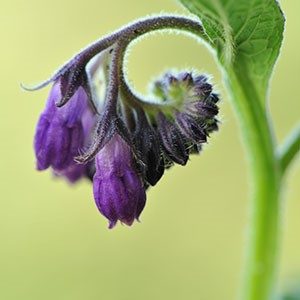Health Benefits of Comfrey
This Amazing Plant has So Many Uses
for Joint Pain & Bone Fractures
Dioscorides, an ancient Greek botanic physician, documents the use of Comfrey in treating the armies of Alexander the Great. The wild Comfrey, Symphytum comes from the Greek word “syumphuo”meaning “to make grow together”, and has been known to herbalists for over 2,000 years. One of the medicinal properties of the comfrey plant is that it is mucilaginous, meaning that it secretes mucilage which can be sticky (a bit like Aloe Vera). Comfrey has also a very high content of allantoin, a substance that promotes new skin cell growth, reduce inflammation, relieve joints in degenerative arthritis and maintain healthy skin. Comfrey contains Vitamin B12, potassium, sulphur, calcium, iron, phosphorus, Vitamin A, Vitamin C, Vitamin B-complex, selenium, iron, germanium and mucilaginous fibre. It is also an excellent source of protein. Comfrey, while considered an important herbal medicine, is controversial due to its toxic components, called pyrrolizidine alkaloids (PAs), which is thought to damage the liver when ingested orally. For this reason, internal use of Comfrey in supplements was banned in the US in 2002. However, new studies including this study suggests that Comfrey toxicity has largely been overrated. As a side note, in my home country, France, many people, including my family, eat and cook Comfrey without experiencing any sides effects. Comfrey also showed good results wen used on children aged 3 and over.
As a general rule, before ingesting Comfrey it’s better to first ask your naturopathic doctor. As far as my experience, as I said, I did eat Comfrey while growing up in France but stopped when I moved to the US, because it was less accessible. I also have a lot of experience using it topically on wounds and can testify to its outstanding efficacy.
When to use Comfrey
For Wound healing. Allantoin, a constituent of the urinary secretions of surgical maggots and of common occurrence in plants and animals, has been found to stimulate healing, with abundant growth of healthy granulation tissue in slowly healing suppurative wounds
Myalgia (muscle pain due to overuse, injury or strain). This study describes the good result in patients suffering from myalgia with a cream made 25% of fresh comfrey.
For Muscles and joints
A 2004 double-blind study of 142 people suffering from ankle sprains found that applying comfrey root extract cream helped to greatly reduce healing time, compared to placebo, says the University of Pittsburgh Medical Center. Another double-blind clinical trial published in 2009 found that comfrey root extract ointment helped to treat acute back pain, according to the Memorial Sloan-Kettering Cancer Center. A three-week-long, double-blind study of 220 people published in 2006 also found that comfrey root extract ointment relieved symptoms related to osteoarthritis of the knee, compared to placebo.
For Perineal healing after giving birth. For Back pain
A new study, funded by the drug company Merck and published in the British Journal of Sports Medicine, showed that people with acute back pain who used an ointment containing comfrey root extract had significant reductions in pain, compared to their peers who used a placebo ointment.
For Painful osteoarthritis
In this study, comfrey was effective in relieving pain and stiffness and in improving physical functioning in those with primary osteoarthritis of the knee without serious adverse effects.
For Blunt injuries
Comfrey root has a strong historical record in the treatment of blunt injuries due to its anti-inflammatory, anti-swelling and pain-relieving properties
For skin rashes
Comfrey root is used in treatment of skin inflammation and leg ulcerations.
During World War II, comfrey was called ” bone knit” and was part of a military first.

